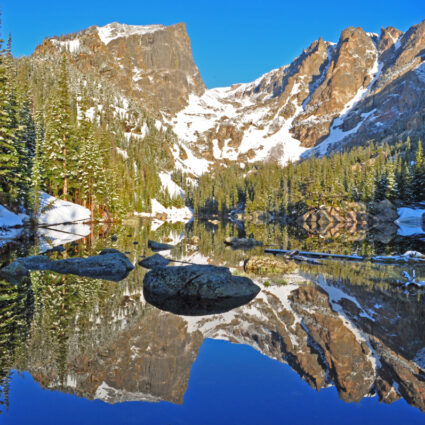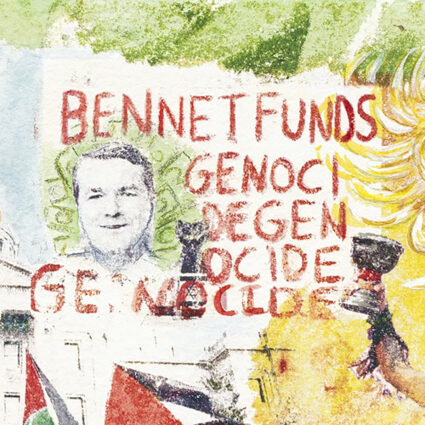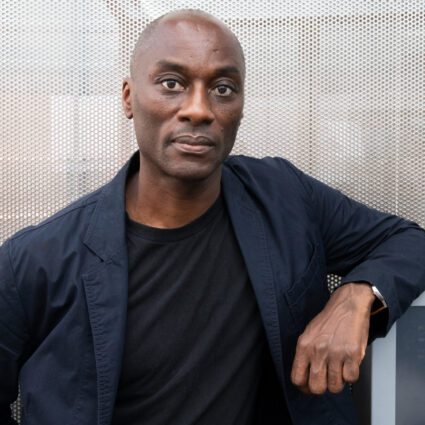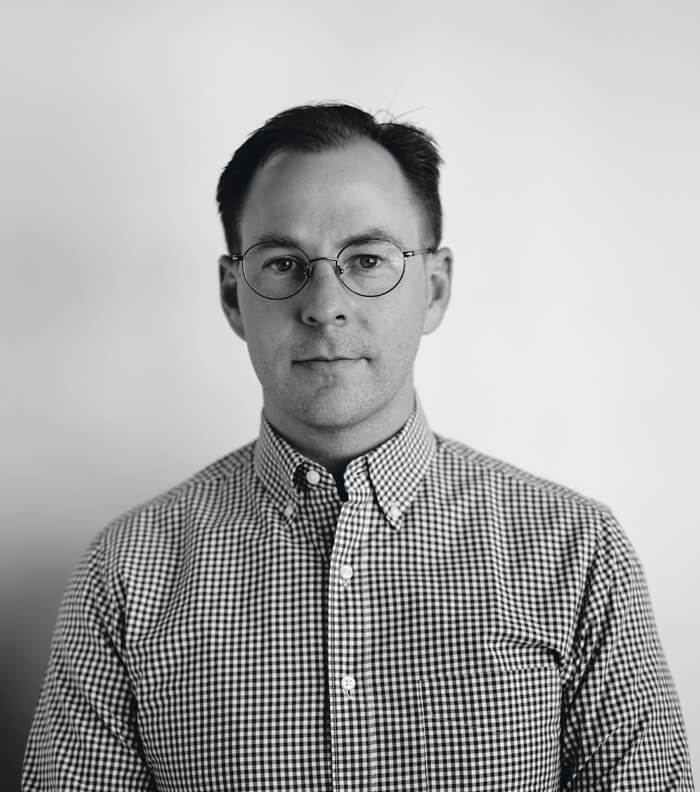
“This rock formation is forty million years old.” Shane Tolbert is guiding me through a narrow passage whose walls contain countless minuscule pebbles and stones—remnants of a mudslide caused by a rush of prehistoric water that cut through the area around the Colorado Plateau and left these finger canyons, some up to forty feet high and just wide enough for our bodies to snake through. This is one of Tolbert’s favorite hikes near Abiquiú, where he has lived since moving to New Mexico from Houston in 2016. We emerge from the canyon into a drastically different landscape, open and bright, cinnabar and chartreuse cliffs in the distance. Tolbert points to a rock cluster, the sandstone worn away to reveal intricate webs of silica. We stand under a 165-million-year-old half-dome bearing the grooves of a long-extinct waterfall.
As a member of the New Mexico Acequia Association Farm Apprentice Program, as a volunteer firefighter, and as full-time staff member at Ghost Ranch, Tolbert has immersed himself in Abiquiú’s local community. But it’s the hikes that most inform Tolbert’s paintings, large-scale canvases that lately feature multiple discs of paint: moons of swirling acrylic, earthy and iridescent.
After our hike, I followed Tolbert to his studio a few miles outside of Abiquiú. The spring wind was up, and as we talked it whipped through the loose panes of the attached greenhouse, which would soon house various flowers and vegetables. Tolbert is preparing over a dozen canvases for an upcoming solo show at McClain Gallery in Houston, working methodically at night and on his days off from Ghost Ranch. On tables, pools of paint and water rest atop sheets of Mylar, wet moons in various stages of drying. Tolbert would be the first person to tell you he’s still in the early stages of understanding his own practice, which is barely a decade in the making. I asked him to walk me through his process, and we discussed how his paintings have evolved since moving to New Mexico.

Shane Tolbert: So here’s an early work, this was in my first solo show with Hiram Butler Gallery in Houston [Visions of an Epileptic, next page]. This is very typical of my work in grad school, and this is really when I started asking myself hard questions about painting: What is painting? What is materiality? What is truth in materials? What qualifies as a painting? I sat in my studio and I wrote, “What are the rules of painting?” I think I wrote about five lines. And the only one that made sense to me was considering a reductive practice of painting. What if a painting starts out with pigment already in it, and then the image is created by pulling it out? This was also when I was really digesting Sam Gilliam’s work—
Chelsea Weathers: I just saw one of his huge hanging canvases in Soul of a Nation at Crystal Bridges.
Right, the joy of revisionist art history. He was totally left out of a thread. I first saw his work when I was already in too deep with Helen Frankenthaler and Morris Louis. So I was spending a lot of time with Sam’s work, and that’s when I started thinking about staining and blowing pigment. I wanted to make a painting without paint. So this process was all bleach.
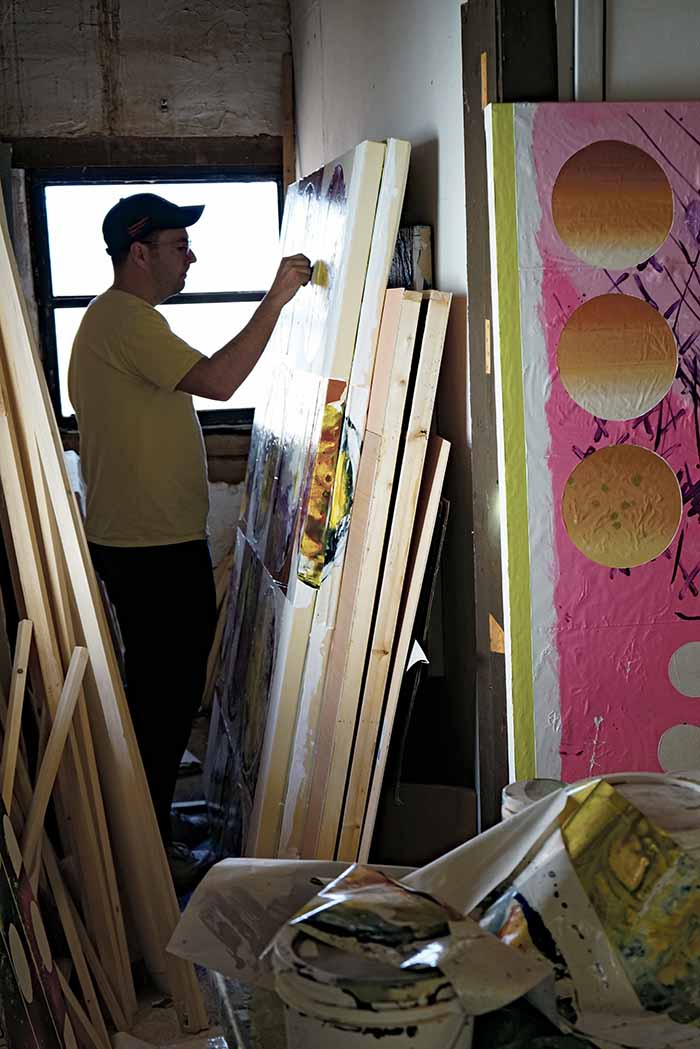
And you did a bunch of these.
I did. I had my MFA thesis show [at University of California, Santa Barbara], then a solo show at what was then the Contemporary Arts Forum (now it’s called the Museum of Contemporary Art, Santa Barbara), and then the show with Hiram. Wendy Vogel reviewed the one in Houston. I was a young pup, and my favorite line of hers was something like, “It’s like a kid wearing his dad’s leather jacket. It doesn’t quite fit yet.” I was included in the Texas Biennial with this work in 2011. It was the year after grad school, and I had moved back to Houston to teach at the University of Houston.
Clayton Porter: You were also an art handler in Houston. How did that give you a different perspective on art?
When you go through school, you get a very academic understanding of what art is, placing artists in a time and a place, categorizing, prioritizing. But when you’re art-handling, you’re in the belly of the beast. You’re in the system of moving parts to make this cultural institution run. Being a preparator, being a crate builder, being a registrar, it’s exposure. I worked for a crate shop in Houston, and then from that I went to work at Sicardi Gallery, which opened me up to a thread of Latin American modernism from postwar to the present. Hélio Oiticica changed my life as an artist. Our minimalists—I mean Judd and Flavin are great, but Latin American interpretations of the same impulses are really dynamic, and when I was an art handler, I was responsible for installing these museum-quality pieces, looking at the back side, working with them. There’s an intimacy to it that really gave me a deeper understanding of object-making. Not just seeing a work in a textbook but seeing it in space, with light reflecting on it and seeing the scale of it, the human interaction to that scale. I think everybody should spend a year as an art handler, if they’re a maker.
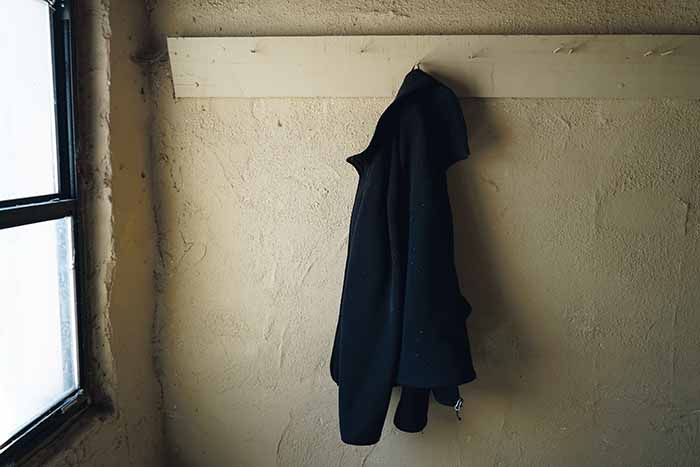
Let’s talk about what your work is like now.
When you think about the history of painting, which is thousands of years old, if you want to chip away some kind of innovation, you constantly have to think what does it mean to make a painting in whatever time you’re living, and also what materials are you comfortable with? I’ve always been a process-based painter. I started working with acrylic when I had to stop working with bleach [because of its toxicity], and I’m comfortable with acrylic paint. And it’s not oil. I’m never going to try to make an oil painting with acrylic; I’m never going to ask one medium to do the job of another. So when I started working with acrylic, I had to ask myself, “What is unique about this paint and the properties of this paint that do not exist in other types of paint?” And it’s a polymer; it’s plastic. So then I thought, “What’s an interesting way to apply it?” I was asking these questions, and I didn’t have answers for the first six months of working with it. I went to Montauk and did the Edward Albee Foundation residency and that’s when I just stumbled onto pressing a sheet of plastic against a wet painting overnight, and the next morning, when I came down to work, I pulled them apart and there was this surface to it. That’s when a light went off in my head, and things just changed. I like thinking of an image that forms through its own process of being used. That informs a lot of my image-making, and really it’s me assembling it, allowing it to form its own image. I put rules in play and then they play out.
nothing’s precious. When you see a moment of character, just let it exist on its own.
I gradually moved to painting directly on the plastic sheeting. And then I started getting more confident playing with color and liquidity. Then fast-forward to being here in Abiquiú and surprising myself with an interest in geology and the landscape. That’s when I started considering erosion and the intersection of erosion with the way that my work is formed. This pigment creates peaks and valleys, and the water is gravity-fed, but the water separates the pigment and pushes it. I tried to figure out how I can respond to the setting that I’m in and make works that can speak to that.

Once the paint on the plastic sheets is dry, I then pull the sheeting off, and this is probably one of the most valuable parts of the process and what’s so compelling and exciting for me. I feel like I’m sharing a language and having a conversation with a lot of Latin American artists and post-minimalists who were so fundamental to my interests. The surface holds the language of this commercially processed plastic sheeting. All of these ripples that it gets from slight wrinkles in the folding process or these creases that form when they have to fold it then roll it—I love that I capture that process language on the surface of these paintings. So I have gesture, and it’s grounded in my location, but it also speaks to a process history that’s really compelling to me.
These disc forms predate your move to Abiquiú. When did they become moons?
Night hikes. That language took shape when I lived in a place with no light pollution. When I moved out here, during full moons I would go on hikes at Chimney Rock at Ghost Ranch.
Your earlier paintings that feature discs are pretty monochrome compared to the ones you’re doing now.
Yes. I completely value clean formalism and investigation and image making, but when I was able to anchor my formal investigations on something tangible and in the real world, the work opened up for me.

You often use these colors that don’t look natural, that are almost neon or fluorescent, but you combine them with warmer earth tones.
Yeah, these toxic and synthetic colors: that’s tied into the language of the material. I’ve always found value in subtlety but also in big pendulum swings on a spectrum.
Drama.
Yeah, drama. Like, obviously the pearlescent paint I sometimes use is very synthetic, but it activates. There are two painters that constantly bounce around my head in the studio: Suzan Frecon is all about natural elements, passing time, light, really just kind of monastic paintings—orbs, shapes, but with rich earth tones. I feel connected to her; I’m in conversation with her when I’m in this landscape. The other one is David Novros. I saw some of his iridescent shaped-canvas paintings at The Menil Collection, and they totally changed the way I perceive that kind of paint as a decorative element only used in a kind of “low” arts-and-crafts world. It activates space in a way that only acrylic paint can, and it activates the surface. You engage the painting by moving across it, not by standing in place, and I think that that’s a very unique thing to be able to share with someone.
I really like how this one pool of paint has broken out of the boundaries of the disc.
That comes from a basic rule in the studio and something that I would always share with my students when I did teach, which is that nothing’s precious. When you see a moment of character, just let it exist on its own. And it’ll be heightened when you maintain your own internal system of the painting.
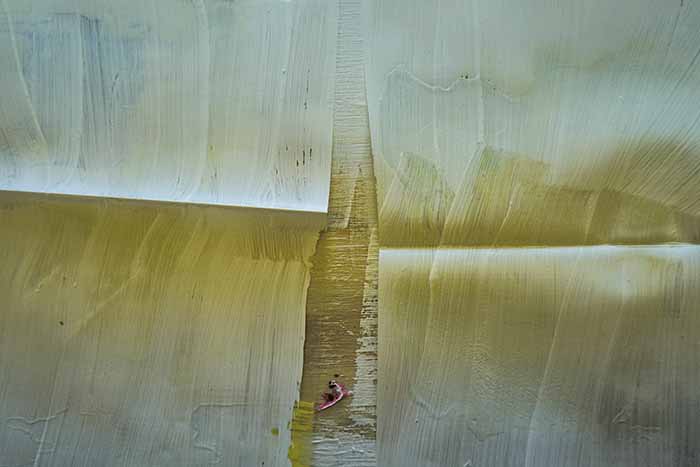
Do you miss teaching?
I don’t. I was raised by two teachers, so I have an immense respect for education, but I started teaching at a young age. I taught a graduate seminar on contemporary painting and my students were older than me. It didn’t feel appropriate to be teaching, because as an artist I didn’t have enough collective life experience to have some sort of earnest conversation about why you’re making what you’re making. I think in another decade I would feel a lot more settled and like working with students and helping them, but it just didn’t seem right. And I just like being in this process of being an artist for a long time and unlocking a door and feeling more settled into what it means to be making. Because what else are you going to talk about?
There are certain through lines from your early work to now. There are grids, there are chance operations, and then the discs. Then you come to New Mexico and you’re starting to bring representation—well I guess not representation necessarily but—
The world back into the work. Yeah. And that’s very intentional. It’s nice to give structure to experience and location. When I think about my palette, I think about temperature not just as visual but symbolic, like the heat of the columns we were walking past today. Like what is ten thousand years of moonlight on a rock? The poetics of these things—how is that visualized or felt or experienced? How do those things that are indefinable accumulate, and how can you create a language for someone else to maybe experience it?

I’m going to be thinking about ten thousand years of moonlight on a rock for a while.
I know, right? These night hikes are just magic, and when I moved out here I was like, “I’m never leaving.”
You work and live at Ghost Ranch. What’s that like?
I live two miles from O’Keeffe’s house, so it’s really special waking up there every morning and seeing Pedernal in the background. It’s a crazy place to be, and it’s a blessing to get to have a reason to live here, and that job allows me the opportunity to be out here. In all of New Mexico, the population is only about two million people. And that’s all I have to say when people ask me why I moved out here. Solitude. It’s peaceful. There aren’t a whole lot of us, and that’s kind of a luxury in an overpopulated planet.
Clayton: How long have you been here?
A year and eight months.
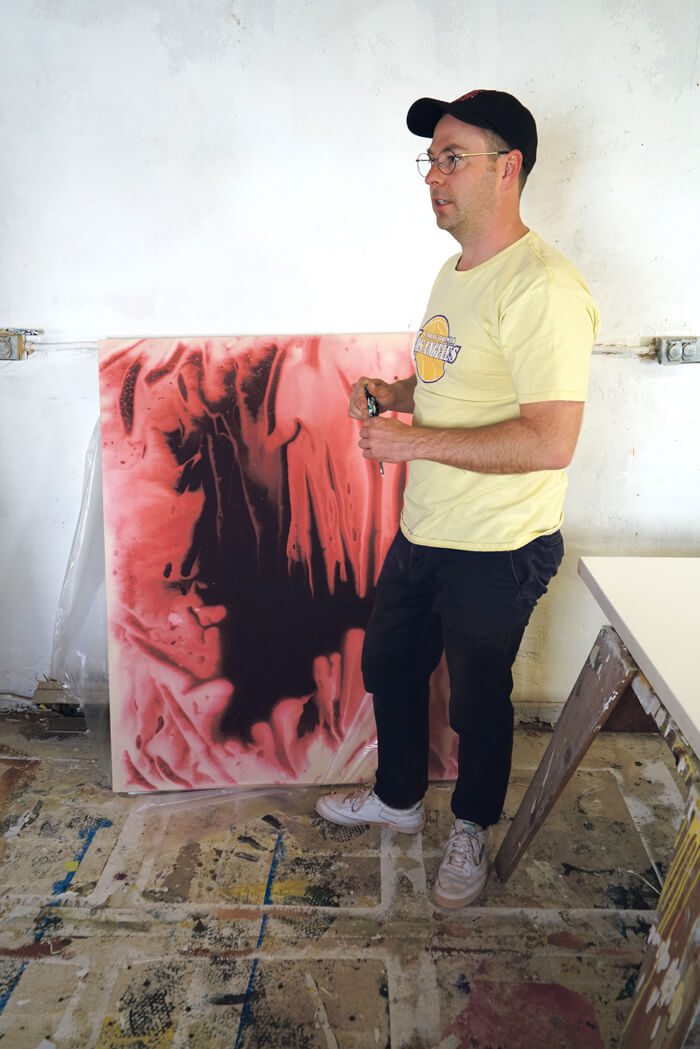
Was the job at Ghost Ranch a deciding factor for why you came out here?
No. I literally just picked up and moved. I had nothing waiting for me out here. I walked away from a job that I was miserable at that I think also impacted my studio practice. Thankfully, my sister and brother-in-law let me stay in their guest house for a couple of months. But I came out here with nothing on my plate. And I knew I wanted to farm, so I knew it was meant to be when I opened the Green Fire Times and on the classified page there was an ad that said, “Apply now for the New Mexico Acequia Association Farm Apprentice Program.” So I answered the ad and ended up getting interviewed, getting one of those spots, and I spent my first year here farming. And about eight months into that, I thought, “Okay, I really love Abiquiú; I just landed this studio; how can I stay out here?” And that’s when I started working at Ghost Ranch.
You mentioned a miserable job.
It was global relocation services, which is a very specialized type of residential real estate. It was a remarkable job, and I was really good at it because when I start something I just dive into it. It was wild: I was working eighty-hour weeks, doing conference calls at 3 am with a client in Singapore, or a client in the Middle East who’s moving because they’re an engineer and they’re going to be working at the new Exxon-Mobil campus north of Houston. I just couldn’t do it anymore. It was one of those crossroad moments, and I had to make a decision that painting is what I’m passionate about, and this is where I’m putting all my energy.
Chelsea: New Mexico seems to have a strong tradition of artists who have had fruitful careers but for whatever reason didn’t immerse themselves in cities with strong arteries of collecting and commercialism.
I’m trusting the system. Because I’ve been at it for a while now, and the goal for me for the longest time was to have a New York show. And you would think being in Houston there would be a lot more opportunities for me to intersect with people who could open something like that up, but it never did. And then I just make a personal decision, not some strategic decision, to come to Abiquiú, away from everything, and suddenly stuff just starts opening up for me, and I get offered my first New York show [at David Richard Gallery]. So really, it still doesn’t make any sense to me how things work out.

